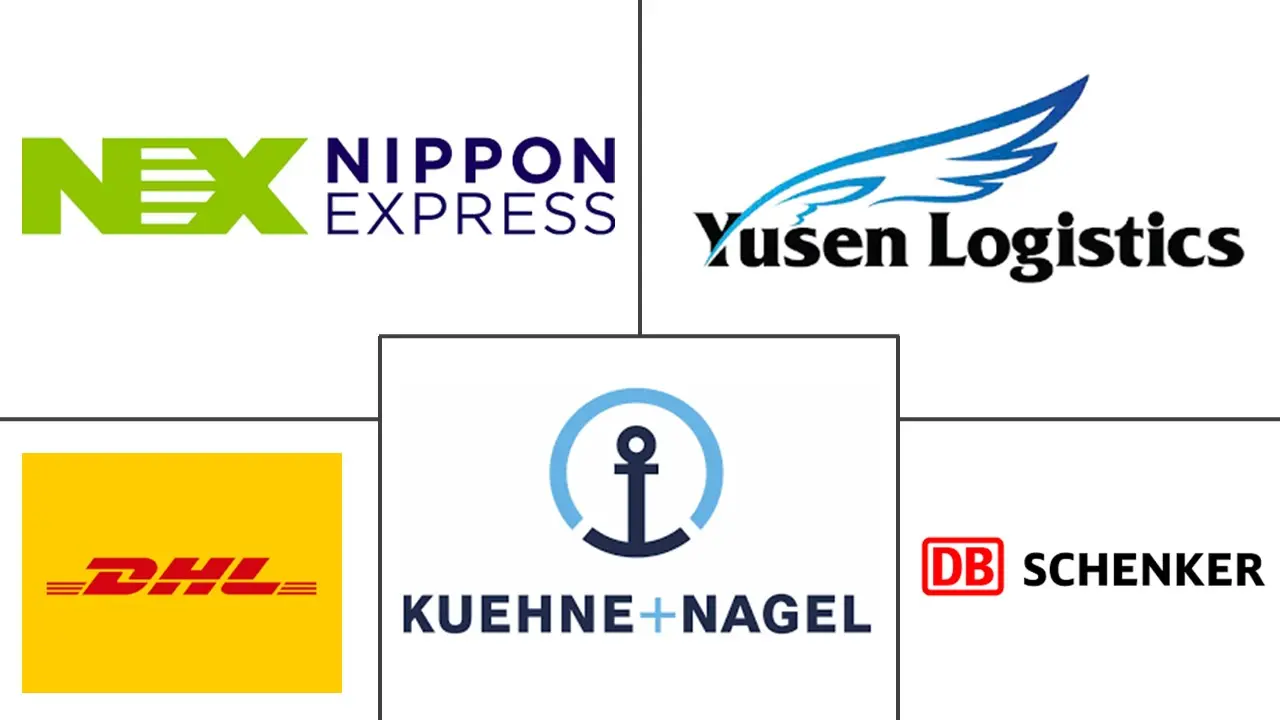Market Size of Semiconductor Logistics Industry

| Study Period | 2020 - 2029 |
| Base Year For Estimation | 2023 |
| CAGR | 7.00 % |
| Fastest Growing Market | Asia-Pacific |
| Largest Market | North America |
| Market Concentration | Low |
Major Players*Disclaimer: Major Players sorted in no particular order |
Semiconductor Logistics Market Analysis
The Semiconductor Logistics Market is anticipated to register a CAGR of more than 7% over the forecast period. The market is driven by the huge demand for semiconductors from different segments. Furthermore, the market is driven by the huge opportunities in logistics improvement to cater to the manufacturing and supply chain in the semiconductor industry.
- There has been an increasing demand for smart devices, the need for sustainable production methods, the importance of cultivating a talent pool, and growth in APAC's semiconductor market share will shape the semiconductor logistics industry. However, supply chain and labour disruptions caused by COVID-19 had resulted in a worldwide chip shortage crisis, which had been exacerbated by ongoing trade tensions between the US and China, as well as conflict in Russia. The pace of technological advancement will quicken. The construction of 5G networks and the Internet of Things has already laid the groundwork for connectivity and automation.
- Insufficient manufacturing capacity to meet market demand is a key thematic trend permeating many facets of the semiconductor supply chain. Semiconductors are essential components in many renewable energy applications, electric vehicles, smartphones and other personal electronics, data centres, and even defence weapons. However, behind the scenes, today's semiconductor companies are facing a slew of challenges. Even at full capacity, fabs have been unable to meet demand, resulting in product lead times of six months or longer. The ongoing semiconductor shortage is now making headlines regularly, especially when it forces automotive OEMs to delay vehicle production. Furthermore, semiconductor firms are dealing with increased design complexity, a talent shortage, and pandemic-related issues, all of which are disrupting the complex, global supply chain that connects players in different markets.
- The semiconductor industry must see the logistical challenges of the last two years as a wake-up call that drastic action is required. When COVID-19 went into effect, many businesses saw a significant drop in sales. The automotive industry lost 80% of its buyers, resulting in a sharp drop in semiconductor demand. Some predict a global semiconductor shortage that will last until 2024. Between 2020 and 2022, it was estimated that these shortages cost the global economy more than USD 500 billion. Worse than the immediate financial impact, these shortages have revealed that semiconductor supply chains are inadequate. Several obvious flaws have been exposed, and addressing them requires more than simply catching up on order backlogs.
- The future of semiconductor companies is dependent on finding a way to compete with logistical challenges as a signal that drastic action is required. Because the demand for semiconductors is only going to increase, those who can get them to end users more efficiently will be the ones to benefit the most in the coming years. The semiconductor value chain is unusually complex, relying on a global network of material and equipment suppliers. This makes efficient supply chain management extremely difficult, resulting in excess stock and routine bottlenecks. A good example is freight management. Freight issues, ranging from port congestion to container shortages, can result in longer lead times and longer shipment delays. Other factors influencing the supply chain include humidity, shock impact, and theft. But without precise data on the progress of shipments and GPS tracking, leaders are often left operating in the dark.
Semiconductor Logistics Industry Segmentation
Semiconductor Manufacturing refers to any process or operation that produces semiconductor material, such as slicing or polishing semiconductor material, using photoresists to make intermediate products, or producing semiconductor devices or related solid-state devices. Logistics refers to the process of lifting coal from mines and bulk transportation, which includes loading and unloading at various points as required to complete the transportation. A complete background analysis of the Semiconductor Logistics Market, including the assessment of the economy and contribution of sectors in the economy, market overview, market size estimation for key segments, and emerging trends in the market segments, market dynamics, and geographical trends, and COVID-19 impact, is covered in the report.
The Semiconductor Logistics Market is segmented By Function (Transportation, Warehousing and Distribution, and Value-added Services), By Destination (Domestic and International). The report offers market size and forecast values (USD billion) for all the above segments.
| By Function | ||||||
| ||||||
| Warehousing and Distribution | ||||||
| Value-added Services (Packaging, Customs Clearance, Freight Brokerage, and Other Services) |
| By Destination | |
| Domestic | |
| International |
Semiconductor Logistics Market Size Summary
The Semiconductor Logistics Market is poised for significant growth, driven by the escalating demand for semiconductors across various sectors and the need for enhanced logistics solutions to support the industry's manufacturing and supply chain demands. The market is experiencing a transformation due to the increasing adoption of smart devices, the push for sustainable production methods, and the expansion of the semiconductor market in the Asia-Pacific region. However, the industry faces challenges such as supply chain disruptions, labor shortages, and geopolitical tensions, which have highlighted the inadequacies in current semiconductor supply chains. The rapid advancement of technologies like 5G and the Internet of Things is further intensifying the need for efficient logistics solutions to meet the growing demand for semiconductors in applications ranging from renewable energy to automotive and consumer electronics.
The competitive landscape of the Semiconductor Logistics Market is characterized by a fragmented structure with numerous local, regional, and global players. Companies like DHL, Nippon Express, Yusen Logistics, DB Schenker, and Kuehne+Nagel are key players leveraging advanced technologies to enhance supply chain visibility and efficiency. The market is witnessing a shift towards more resilient and flexible supply chains, with a focus on diversifying partnerships to mitigate risks associated with overreliance on single suppliers. Recent developments, such as Kuehne+Nagel's new air freight offering and Jaguar Land Rover's strategic alliances to secure semiconductor supplies, underscore the industry's commitment to building robust supply chains capable of supporting continuous operations amidst growing demand and manufacturing pressures.
Semiconductor Logistics Market Size - Table of Contents
-
1. MARKET INSIGHTS DYNAMICS
-
1.1 Current Market Scenario
-
1.2 Market Overview
-
1.3 Market Dynamics
-
1.3.1 Drivers
-
1.3.2 Restraints
-
1.3.3 Opportunities
-
-
1.4 Value Chain / Supply Chain Analysis
-
1.5 Industry Attractiveness - Porter's Five Forces Analysis
-
1.5.1 Threat of New Entrants
-
1.5.2 Bargaining Power of Buyers/Consumers
-
1.5.3 Bargaining Power of Suppliers
-
1.5.4 Threat of Substitute Products
-
1.5.5 Intensity of Competitive Rivalry
-
-
1.6 Impact of the COVID-19 on the Market
-
-
2. MARKET SEGMENTATION
-
2.1 By Function
-
2.1.1 Transportation
-
2.1.1.1 Roadways
-
2.1.1.2 Railways
-
2.1.1.3 Water and Seaways
-
2.1.1.4 Airways
-
-
2.1.2 Warehousing and Distribution
-
2.1.3 Value-added Services (Packaging, Customs Clearance, Freight Brokerage, and Other Services)
-
-
2.2 By Destination
-
2.2.1 Domestic
-
2.2.2 International
-
-
Semiconductor Logistics Market Size FAQs
What is the current Semiconductor Logistics Market size?
The Semiconductor Logistics Market is projected to register a CAGR of greater than 7% during the forecast period (2024-2029)
Who are the key players in Semiconductor Logistics Market?
DHL, Nippon Express, Yusen Logistics, DB Schenker and Kuehne+Nagel are the major companies operating in the Semiconductor Logistics Market.


